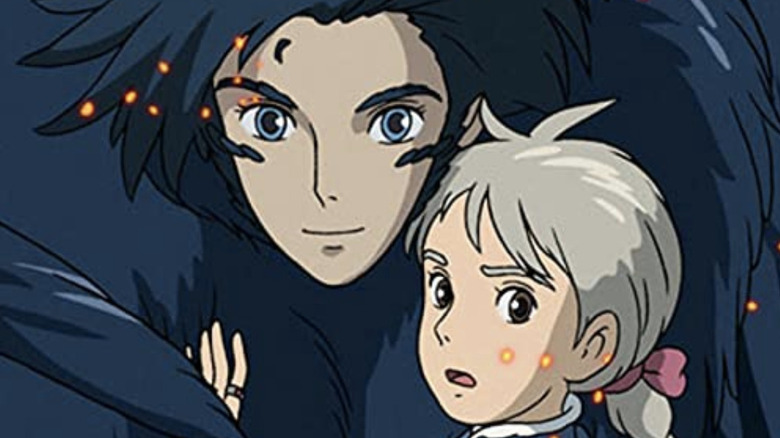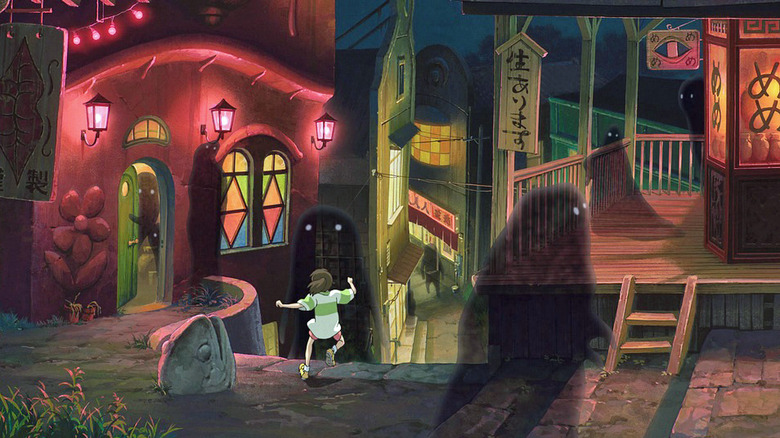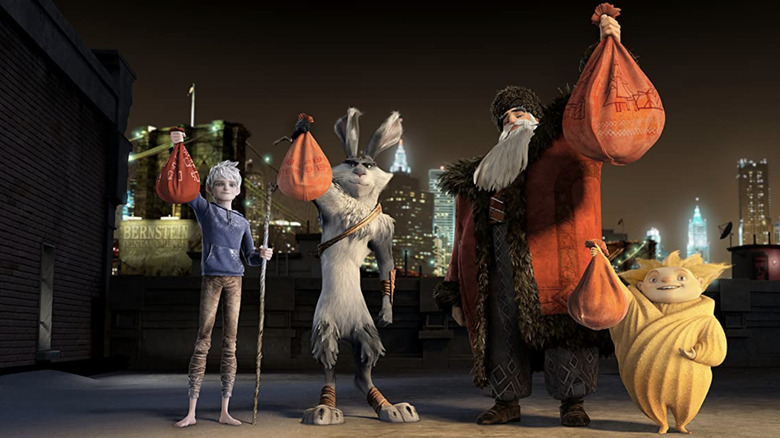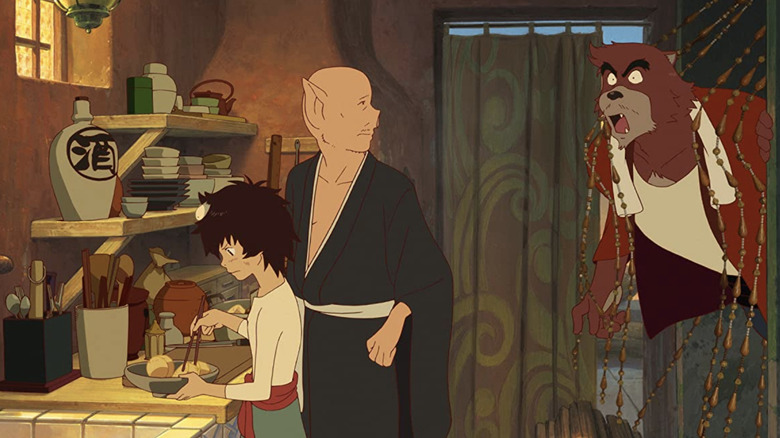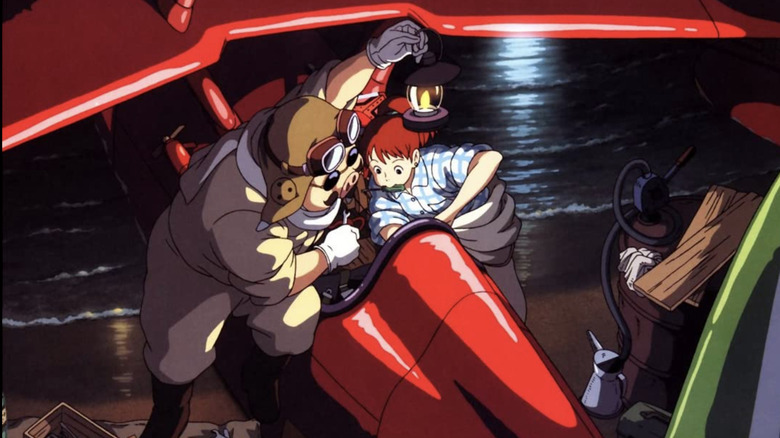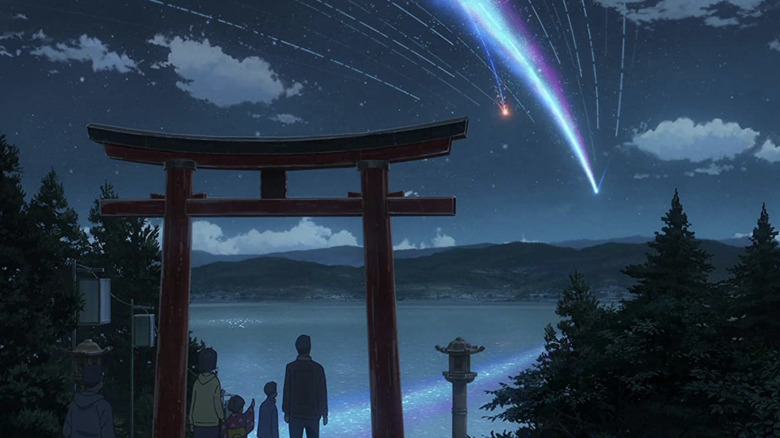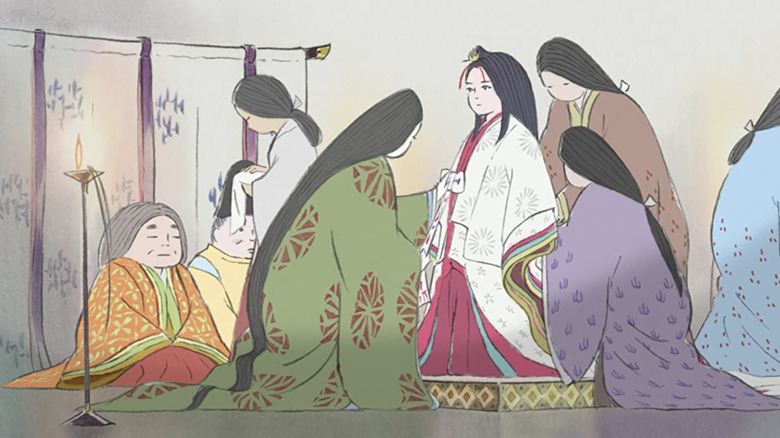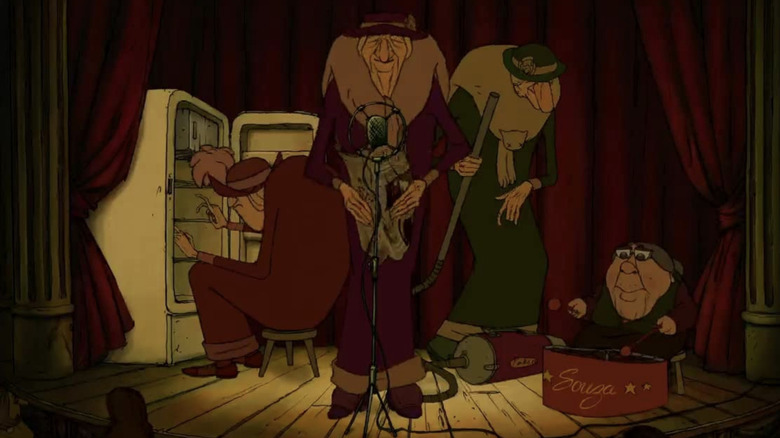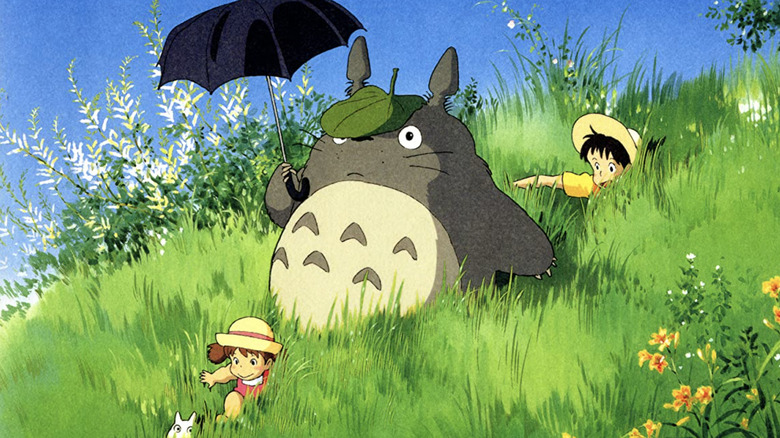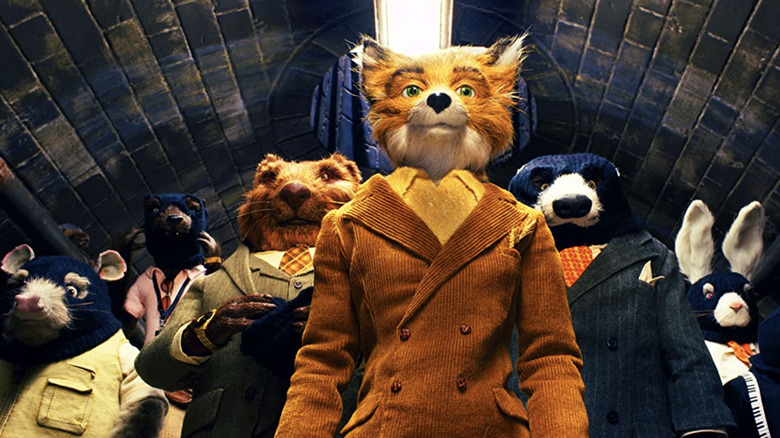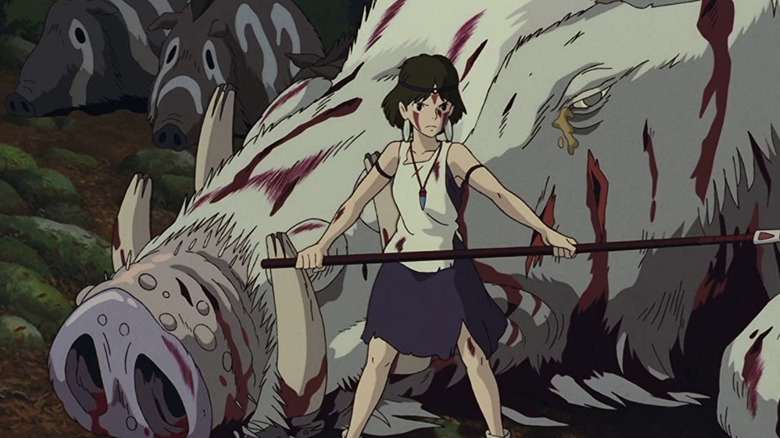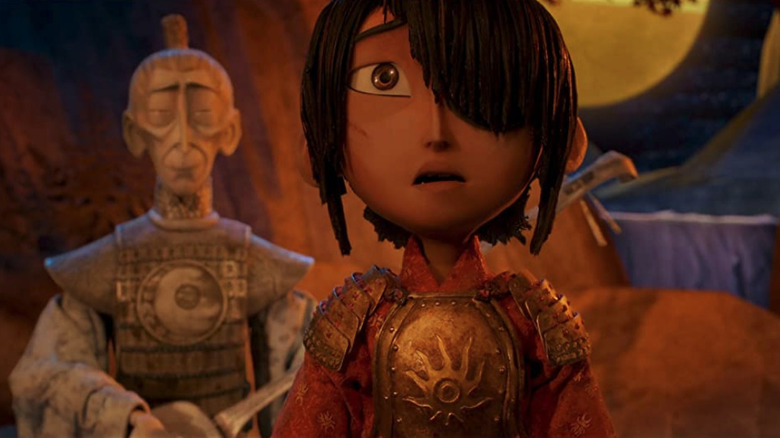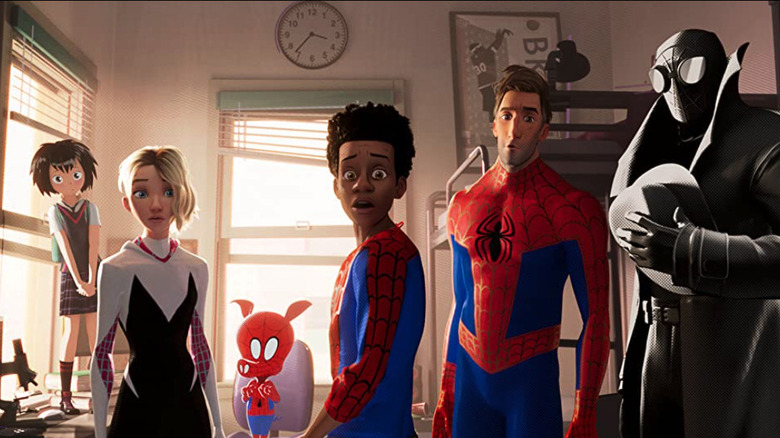Movies Like Howl's Moving Castle That Are Definitely Worth Watching
Studio Ghibli and its founder and main director, Hayao Miyazaki, are known for producing whimsical animated films, and 2004's "Howl's Moving Castle" is one of their best. The film follows Sophie, a young hat maker who has a chance encounter with the wizard Howl, a mysterious and enchanting figure. This draws the attention of the Witch of the Waste, who fancies Howl. She curses Sophie, who turns into a 90-year-old crone.
Leaving everything behind to try and break the enchantment, Sophie tracks down Howl's moving castle, which is literally a monstrous castle roaming the countryside on chicken-looking mechanical legs. Their adventures only get weirder from there. While Howl is a charming character, he is revealed to be very immature and selfish, and prone to mood swings and fits. Sophie has her own growing up to do, as she learns to assert herself and her boundaries vis-à-vis Howl's unreasonable behavior. The kingdom where they are from is stuck in a meaningless war, which acts as a motivator to their respective coming-of-ages. The movie showcases Studio Ghibli and Miyazaki's usual colorful and detailed animation, as well as intriguing characters and profound, serious themes.
"Howl's Moving Castle" is the kind of anime movie that has something for all ages, whether it be the serious anti-war message Miyazaki wanted to express (as he told Newsweek, the film was heavily inspired by his rage towards the second Iraq War), the maturation of both Howl and Sophie, or Markl and Calcifer's funny antics. Here are 12 movies that you should definitely watch if you enjoyed "Howl's Moving Castle."
Spirited Away
Widely regarded as Miyazaki's best film, "Spirited Away" shares the same qualities as "Howl's Moving Castle," which can be attributed to the fact that it comes from the same studio and director. Winner of the Academy Award for best animated feature film in 2002, "Spirited Away" features another feminine heroine, Chihiro, who goes on an adventure-packed supernatural journey that doubles as a coming-of-age story.
On their way to their new house in the countryside, Chihiro and her parents get lost on a road in the woods. As they explore the area, they discover an abandoned village, which is actually a portal to the spirit world. Chihiro's parents are trapped after they indulge in forbidden food, and as Chihiro tries to rescue them, she is cursed by a witch, who steals her name. Unless she can remember what she's called, Chihiro will be trapped in the spirit world forever and forced to work in the witch's bathhouse. The movie is amazingly detailed, with enchanting settings, weird spirits, delightful music, and a slow, deliberate pace that lets the audience drink it all in.
Rise of the Guardians
Director Peter Ramsey reinvents holiday fairytales with "Rise of the Guardians," his 2012 directorial debut. Santa Claus, the Tooth Fairy, the Easter Bunny — they're all fair game in this fun and colorful animated film, which is based on a series of books by William Joyce.
The Guardians are an Avengers-type group dedicated to protecting hope, dreams, wonder, and other important ideas. The group is comprised of North (Alec Baldwin), a heavily tattooed Russian Santa Claus, Bunny (Hugh Jackman), an Australian Easter bunny, Tooth (Isla Fisher), the humming-bird-like tooth fairy, and the Sandman, the mute guardian of Dreams. They enlist Jack Frost (Chris Pine), a young winter spirit who's a bit depressed that no one believes in him, to help them defend the world against the Nightmare King Pitch Black (Jude Law). Jack needs to find his place among the legendary creatures who recruit him, and build up his confidence to become his own myth.
The film is fast-paced, and while it's first and foremost a children's movie, anyone who's grown up believing in these figures will enjoy the characters' quirky reinventions.
The Boy and the Beast
Just like "Howl's Moving Castle," Mamoru Hosoda's "The Boy and the Beast" explores chosen families and immature heroes in a coming-of-age story. Released in 2016, "The Boy and the Beast" follows Ren, a nine-year-old boy who runs away following his mother's death. While out on the streets of Tokyo, he spots a bear-like man, whom he follows into a parallel world called Jutengai, the Beast Kingdom. The man turns out to be an actual, anthropomorphized bear named Kumatetsu, who's one of two heirs to the Beast Kingdom; he's looking for a disciple to train before a big duel with the other heir, Iōzen, and adopts Ren as his apprentice, renaming him Kyūta.
They both have a lot to learn from each other. Kumatetsu is impatient, selfish, and an overall terrible teacher, while Kyūta is a decent young man but is feeling lost and empty, as he doesn't belong in the Beast Kingdom but cannot find his way back to the human world. He eventually does, and after a decade spent with Kumatetsu falls in love with a girl named Kaede, who helps him with his inner demons. The film features delightful hand-drawn animation, and its action sequences are spectacularly executed.
Porco Rosso
Miyazaki displays some more of his anti-war sentiments in "Porco Rosso," which is set in Italy between the two World Wars. His eponymous hero has deserted the Italian army in protest of the fascist government, instead deciding to become a bounty hunter and seaplane pirate. It's easily Miyazaki's most adult-oriented movie, as it tackles real-world events, while still retaining the fantastical whimsy intrinsic to Studio Ghibli films.
Porco Rosso is an ace pilot who suffers from a weird curse that has turned his face into a pig's; he also shares Howl's attitude problem, being kind of a jerk to everyone around him. That includes Gina, the cabaret singer who's in love with him, and Fio, a young female mechanic who helps him repair his plane. Porco Rosso is also in trouble with other pirate gangs, who hire American pilot Donald Curtis to hunt him down, as well as the Italian air force. The flying animation is impeccable, and the whole film has a nostalgic old-Hollywood feel to it.
Your Name
Just as visually striking and romantic as "Howl's Moving Castle," "Your Name" was hugely successful both in Japan and worldwide, and became one of the highest-grossing anime films of all time. Both films also feature characters who grow up by navigating mysterious curses: "Your Name" hinges on a "Freaky Friday" type of situation, with two teenagers who swap bodies randomly.
High-school girl Mitsuha Miyamizu lives a boring life in the countryside of Japan and wishes for urban excitement; the slightly older Taki Tachibana is a shy boy who lives in bustling Tokyo. One morning, they wake up in each other's bodies. Just as mysteriously, they switch back another morning. The two teens learn to communicate through notes and messages as they go about each other's days, ultimately coming to one another's aid. Mitsuha helps Taki by talking to his crush, and Taki helps Mitsuha become more popular at school.
Then, as mysteriously as it started, the body-switching stops. By this point, Taki has fallen for Mitsuha and sets off to find her, which turns out to be more difficult than expected, as the distance is not the only thing separating the two. Despite its fantastic premise, "Your Name" is a grounded and deeply human film showcasing how deep empathy and connection can go.
The Tale of Princess Kaguya
Miyazaki is far from the only filmmaker working at Studio Ghibli. His co-founder, Isao Takahata, is also an acclaimed director. Takahata's most recent film, 2013's "The Tale of the Princess Kaguya," is an enchanting movie based on a Japanese folk tale called "The Tale of the Bamboo Cutter."
In the film, the titular princess is found by a farmer, Sanuki, while out harvesting bamboo: She falls out of a shoot, looking like a tiny fairy, and transforms into a human baby once he brings her home. She grows startlingly fast, and earns the nickname Takenoko (which means little bamboo).
Sanuki keeps discovering great riches in the bamboo grove, and with this bounty decides to buy a castle and make Takenoko into a real princess as befits her beauty, renaming her Kaguya. However, this is not what Kaguya wants for herself. Thus begins a classic battle between father and daughter, leading to a clash between the patriarchy and a woman who pushes back against social conventions. The film is animated in a sketchy, minimalist style, but don't let that fool you into thinking it'll be boring. The movement is smooth and lifelike, and the colors and depth of the images are stunning.
The Triplets of Belleville
While "Howl's Moving Castle" is a little bit weird at times, the animated film "The Triplets of Belleville" really commits to being kooky, creepy, peculiar, and everything in between. A co-production between France, Belgium, and Canada, it is Sylvain Chomet's directorial debut, and it was nominated for two Oscars, including best animated feature.
Set between France and the United States, the story follows Madame Souza, her obese hound Bruno, and her grandson Champion. As she raises Champion in France, Madame Souza initiates him in the world of cycling; he goes on to become a professional cyclist, competing in the Tour de France. He is kidnapped by the French mafia and brought to Belleville, a New York City lookalike in the United States. Madame Souza decides to rescue him and enlists the help of the Triplets of Belleville, a trio of sisters who used to be famous cabaret singers.
The film has almost no dialogue, relying instead on music and the characters' physicality, to tell its story. The color palettes and the characters are grungy and grotesque, and the situations they get into are plain strange, making this a very unique animated film.
My Neighbor Totoro
If you're looking for a coming-of-age tale that is more suitable for children than "Howl's Moving Castle," "My Neighbor Totoro" is a great choice. Another Miyazaki film from Studio Ghibli, "My Neighbor Totoro" is an engaging, colorful tale, and one of the director's most recognizable films; its adorable characters have been made into plushies and printed on all sorts of merchandise for over three decades.
Two sisters, Satsuki and Mei, are moving to a new house with their dad in the same district as the hospital where their mom is being treated. One afternoon, Mei sees a small spirit ambling around the garden, and follows it into the trees. There, she meets a bigger spirit; from its roars, she understands he's named Totoro. Totoro lives in a big camphor tree behind the sisters' house, and he's never far when the girls need some help. The movie doesn't have any big villains and conflicts. It's more of a slice-of-life story, one in a world where spirits are welcome, and illness is just part of life.
Fantastic Mr. Fox
Wes Anderson isn't a necessarily known for animated films, so 2009's "Fantastic Mr. Fox," his first stop-motion animated feature, defied all expectations. "Fantastic Mr. Fox" was praised for its attention to detail and the quality of its animation, as well as for staying true to the Roald Dahl novel it's based on. If you liked the weirdness of "Howl's Moving Castle," then you'll love "Fantastic Mr. Fox."
The titular character, Mr. Fox (George Clooney), is a thief. He steals small animals from farms to feed himself and his family, earning him a bad reputation and a few enemies. One day, as he is trapped in a cage with his pregnant wife, Felicia (Meryl Streep), he promises to change his ways and becomes a journalist.
A few years later, with their now-teenage son, Ash (Jason Schwartzman), in tow, the Fox family moves to a better home that happens to be in close proximity to three very mean farmers. Mr. Fox soon starts stealing again, which puts his family in danger, as the farmers are determined to hunt him until they catch him. Many of Anderson's regular collaborators show up as part of the voice cast, including Bill Murray, Owen Wilson, and Adrian Brody.
Princess Mononoke
If you enjoyed the high stakes, ethical themes, and mature storytelling of "Howl's Moving Castle," then you'll probably enjoy this other Miyazaki masterpiece, "Princess Mononoke." The film is a complex environmental allegory, and it influenced many sci-fi movies and shows, including Star Wars series like "The Clone Wars" and "The Mandalorian."
"Princess Mononoke" starts with the story of Ashitaka, a prince who ends up cursed by a demon as he protects his village. The creature turns out to be a boar god who was himself cursed by a silver bullet they find in his carcass. Ashitaka casts himself out and searches for the cure, retracing the demon's path.
Ashitaka encounters two extremely powerful women during his travels. The first one, Lady Eboshi, runs Iron Town, which is a safe haven for outcasts. She fiercely defends her village from San, a young girl who was raised by the wolf goddess Moro, and who the villagers call "Princess Mononoke"; she resents the humans of Iron Town for polluting the environment. Miyazaki creates strong female characters in this fantastic but grounded world who face similar environmental challenges to the ones we do, and you can't help but feel both sides' humanity.
Kubo and the Two Strings
Another animated movie that knows that its audience, young or otherwise, can handle tough subjects, "Kubo and the Two Strings" is a gorgeously animated stop-motion movie about memory and family. Whereas "Howl's Moving Castle" showed us what a chosen family could look like, "Kubo and the Two Strings" is about how we mythologize our parents and how to deal with memories regarding family members who have passed away.
Kubo is a young Japanese boy who plays the shamisen and tells stories to his village for a living. His dad, a samurai named Hanzo, is long dead, and his mom, Sariatu, is very ill. She shares stories of Hanzo with Kubo, and tells him that his grandfather, the Moon King, stole one of his eyes when he was a baby, and will take the other if he ventures outside at night.
One night during the village's Bon festival, which honors the dead, Kubo gets distracted and forgets to return home before dark; his mother narrowly rescues him from her sisters, who try to capture him for the Moon King. From there, Kubo must wear his father's samurai armor and stand up to his grandfather, accompanied by his sidekicks Monkey and Beetle, who are not who he thinks they are.
Spider-Man: Into the Spider-Verse
"Howl's Moving Castle" and other Studio Ghibli films are considered to be innovative visual spectacles by animation fans. In 2018, another film broke similar creative boundaries: "Spider-Man: Into the Spider-Verse." Aesthetically, the film is a blend of many different animation styles, incorporating manga, comics, 3D animation, and American cartoons into one dazzling psychedelic spectacle.
"Spider-Man: Into the Spider-Verse" follows a Spider-Man most aren't familiar with. Miles Morales (Shameik Moore) is a young Black teenager from New York City who gets bitten by a radioactive spider while painting graffiti in an abandoned subway station. When he returns to investigate his newfound powers, he encounters the real Spider-Man (Chris Pine), as he battles against the crime lord Kingpin (Liev Schreiber), who is trying to use a "Super-Collider" to reach across dimensions and bring his dead wife and child back to life. Spider-Man fails, but has enough time to give Miles a USB key that contains the codes that will disable the collider, which has the power to destroy the whole city.
However, the collider has already successfully breached the multiverse, and a bunch of other Spider-Men come to Miles' aid. Among them are Spider-Woman (Hailee Steinfeld), Peter Porker (John Mulaney), and Spider-Man Noir (Nicholas Cage), all of whom come together in this intelligent, well-written, and stunning movie.
